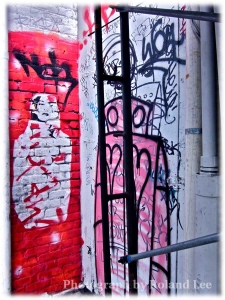 Graffiti are markings that are applied illicitly on walls or other surfaces, usually in a public place. It can damage or weaken the original building material (the substrate), and also leave unsightly markings both from the original tags and the effects of visible overpainting or shadows after removal.
Graffiti are markings that are applied illicitly on walls or other surfaces, usually in a public place. It can damage or weaken the original building material (the substrate), and also leave unsightly markings both from the original tags and the effects of visible overpainting or shadows after removal.
Graffiti also have a strong correlation to crime and undesirable activities that affect the public perception of an area. If applied without owner consent or proper approvals (such as compliance with sign codes or other land use requirements), graffiti is considered vandalism or defacement. Most local jurisdictions have laws against graffiti, with civil and criminal penalties for violations.
The National Park Service Preservation Brief on removing graffiti from historic masonry emphasizes that quick response to remove graffiti as soon as it appears is important both for its elimination and its recurrence. Quickly removing the applied coating can keep it from permanently adhering to the building material. Quick removal also acts as a deterrent to vandalism and reduces the likelihood of recurrence.
The goal for graffiti removal is to remove the marking without damaging the underlying material. It is important to use the gentlest means possible to avoid harming the substrate. Otherwise, the graffiti removal can be as harmful or disfiguring as the markings themselves.
To select an appropriate removal method, it is necessary to identify both the material of the substrate (such as brick, basalt, glass, concrete, or wood) and the media of the coating (e.g. spray paint, ink, wax, or markers).
Download the WJE Report on Graffiti Cleaning & Prevention (PDF)
A recent technical study of graffiti prevention and removal in Honolulu’s Chinatown identified four major graffiti removal methods: microabrasion, chemical methods, water methods, and overpainting. Any method should be tested on mock-ups or small areas before applying more widely.
- For Hawaii’s commercial historic buildings, the primary recommendation is to use low pressure rinsing with a neutral or non-ionic detergent. Make sure the mortar is well-pointed before using pressure washing to avoid water damage. Open joints should be sealed and the façade should be watertight. The application should also avoid using tools that would damage the stone or masonry, such as wire brushes or scrapers.
- Chemical cleaning tests found that “Dumond Smart Strip Pro” was most effective chemical removal method for spray paint and silver coating on basalt and brick (but not for use on softer materials, like limestone or marble substrates). It is more effective when used on freshly applied paint. Be sure to follow all safety instructions, manufacturer’s directions, and disposal directions to protect against environmental contamination. For more information and availability go to www.dumondchemicals.com
- Overpainting may be used on surfaces that were painted historically, such as stucco or painted brick, but should not be used on surfaces that were historically not painted. The paint is used to cover the graffiti instead of removing it. It should match the base paint in color and sheen, and be compatible with the base paint.
The study also examined available protective coatings that serve as a barrier to prevent the markings from adhering to the substrate. Unfortunately, none of the tested materials proved to be effective and many of them left files and discoloration on the substrate. Other prevention methods include site modifications, such as lighting, security cameras, and spikes or barbs on horizontal surfaces.
Sources:
- Preservation Brief 38: Removing Graffiti from Historic Masonry, NPS Technical Preservation Services; http://www.nps.gov/tps/how-to-preserve/briefs/38-remove-graffiti.htm
- Historic Chinatown Buildings Graffiti Cleaning and Prevention, Honolulu, Hawai‘i, WJE for Honolulu Authority for Rapid Transportation (2015)

